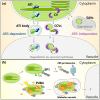Chloroplast Protein Turnover: The Influence of Extraplastidic Processes, Including Autophagy
- PMID: 29534549
- PMCID: PMC5877689
- DOI: 10.3390/ijms19030828
Chloroplast Protein Turnover: The Influence of Extraplastidic Processes, Including Autophagy
Abstract
Most assimilated nutrients in the leaves of land plants are stored in chloroplasts as photosynthetic proteins, where they mediate CO₂ assimilation during growth. During senescence or under suboptimal conditions, chloroplast proteins are degraded, and the amino acids released during this process are used to produce young tissues, seeds, or respiratory energy. Protein degradation machineries contribute to the quality control of chloroplasts by removing damaged proteins caused by excess energy from sunlight. Whereas previous studies revealed that chloroplasts contain several types of intraplastidic proteases that likely derived from an endosymbiosed prokaryotic ancestor of chloroplasts, recent reports have demonstrated that multiple extraplastidic pathways also contribute to chloroplast protein turnover in response to specific cues. One such pathway is autophagy, an evolutionarily conserved process that leads to the vacuolar or lysosomal degradation of cytoplasmic components in eukaryotic cells. Here, we describe and contrast the extraplastidic pathways that degrade chloroplasts. This review shows that diverse pathways participate in chloroplast turnover during sugar starvation, senescence, and oxidative stress. Elucidating the mechanisms that regulate these pathways will help decipher the relationship among the diverse pathways mediating chloroplast protein turnover.
Keywords: Rubisco-containing bodies; autophagy; chlorophagy; chloroplasts; photooxidative damage; plants; senescence; sugar starvation; ubiquitin proteasome system; vacuole.
Conflict of interest statement
The authors declare no conflicts of interest.
Figures


Similar articles
-
Partial or entire: Distinct responses of two types of chloroplast autophagy.Plant Signal Behav. 2017 Nov 2;12(11):e1393137. doi: 10.1080/15592324.2017.1393137. Epub 2017 Oct 17. Plant Signal Behav. 2017. PMID: 29040052 Free PMC article.
-
Roles of autophagy in chloroplast recycling.Biochim Biophys Acta. 2014 Apr;1837(4):512-21. doi: 10.1016/j.bbabio.2013.11.009. Epub 2013 Nov 19. Biochim Biophys Acta. 2014. PMID: 24269172 Review.
-
Vacuolar degradation of chloroplast components: autophagy and beyond.J Exp Bot. 2018 Feb 12;69(4):741-750. doi: 10.1093/jxb/erx234. J Exp Bot. 2018. PMID: 28992297 Review.
-
Entire Photodamaged Chloroplasts Are Transported to the Central Vacuole by Autophagy.Plant Cell. 2017 Feb;29(2):377-394. doi: 10.1105/tpc.16.00637. Epub 2017 Jan 25. Plant Cell. 2017. PMID: 28123106 Free PMC article.
-
Senescence-associated degradation of chloroplast proteins inside and outside the organelle.Plant Biol (Stuttg). 2008 Sep;10 Suppl 1:15-22. doi: 10.1111/j.1438-8677.2008.00089.x. Plant Biol (Stuttg). 2008. PMID: 18721308 Review.
Cited by
-
Photosynthesis in a Changing Global Climate: Scaling Up and Scaling Down in Crops.Front Plant Sci. 2020 Jul 6;11:882. doi: 10.3389/fpls.2020.00882. eCollection 2020. Front Plant Sci. 2020. PMID: 32733499 Free PMC article. Review.
-
An additional role for chloroplast proteins-an amino acid reservoir for energy production during sugar starvation.Plant Signal Behav. 2019;14(1):1552057. doi: 10.1080/15592324.2018.1552057. Epub 2018 Dec 3. Plant Signal Behav. 2019. PMID: 30507341 Free PMC article.
-
Autophagic Turnover of Chloroplasts: Its Roles and Regulatory Mechanisms in Response to Sugar Starvation.Front Plant Sci. 2019 Mar 22;10:280. doi: 10.3389/fpls.2019.00280. eCollection 2019. Front Plant Sci. 2019. PMID: 30967883 Free PMC article. Review.
-
Differentiation of chromoplasts and other plastids in plants.Plant Cell Rep. 2019 Jul;38(7):803-818. doi: 10.1007/s00299-019-02420-2. Epub 2019 May 11. Plant Cell Rep. 2019. PMID: 31079194 Free PMC article. Review.
-
Specificity of H2O2 signaling in leaf senescence: is the ratio of H2O2 contents in different cellular compartments sensed in Arabidopsis plants?Cell Mol Biol Lett. 2022 Jan 6;27(1):4. doi: 10.1186/s11658-021-00300-w. Cell Mol Biol Lett. 2022. PMID: 34991444 Free PMC article. Review.
References
-
- Mae T., Ohira K. The remobilization of nitrogen related to leaf growth and senescence in rice plants (Oryza sativa L.) Plant Cell Physiol. 1981;22:1067–1074. doi: 10.1093/oxfordjournals.pcp.a076248. - DOI
Publication types
MeSH terms
Substances
LinkOut - more resources
Full Text Sources
Other Literature Sources

